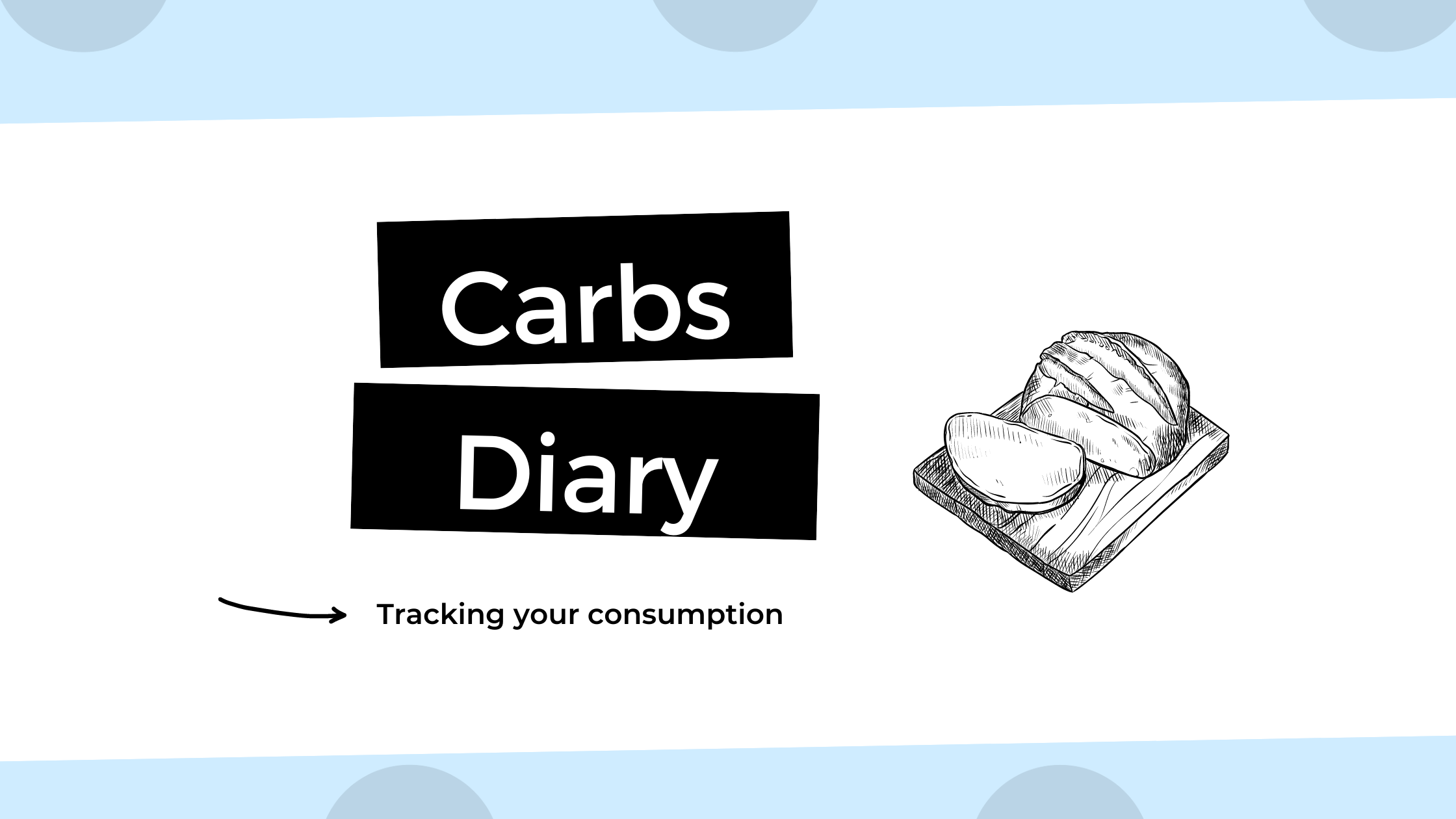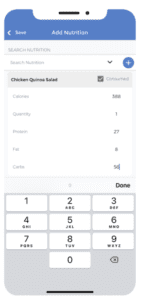
Do all of your favorite foods happen to be carbs? You’re not alone. Carbohydrates are a wide and delicious branch of food that form the base of many diets around the world. Unfortunately, we are not free to consume carbs with reckless abandon, as much as we might be craving carbohydrates. There can be some serious health problems associated with carbohydrate intake. In this article, we want to impress the usefulness of tracking your carb intake, through using something like a carbohydrate counter. We’ll go through a broad overview of carbs and some examples, discuss their impact on health, and then finish with a way to effectively track your carbs.[1][2]
What are carbohydrates?
Carbohydrates are one of the three main macronutrients, along with proteins and fats. Carbohydrates appear in lots of different forms and in many different foods. There has been much discussion about whether different carbs are healthy or not. Many studies have found that high consumption of certain kinds of carbs can lead to disease. Let’s break down exactly what a carb is and how it may be used in the body.
Function
Carbohydrates are used in many different ways in the human body. This is because of how diverse they can be in shape and size. One of the primary functions of a carb is as an energy source. This is true especially of the big carbs, such as the starch found in potatoes. These carbs consist of lots of small molecules linked together in a long chain. When these carb molecules mix with the oxygen that we breathe in, energy is released! This process is super complex and is known as carbohydrate metabolism.
As you are probably aware, there are many different forms of carbohydrates that we eat everyday. Let’s take a look at some of the most simple, basic forms of carbohydrates and how these are classified.
Chemical Structure
At the most basic level, a carbohydrate is a molecule made up only of elements carbon, hydrogen and oxygen. These elements can be arranged in many different ways, and is the reason why there are so many different kinds of carbohydrates. For example, many carbs are arranged as a ring of carbon atoms with little oxygen and hydrogen groups attached on the outside. These are known as saccharides. Some examples of saccharides include sugars and starches, as well as cellulose which is found in plants.
Sugars
Simple sugars are a broad class of carbohydrates that include the following molecules, some of which you may have heard of already:
- Glucose – one of the most well known sugars. Glucose is a small saccharide (a monosaccharide) that is found in most plant foods. The main reason why your apple tastes sweet is because of glucose!
- Sucrose – a combination of glucose and another similar molecule known as fructose. Because it is made of two saccharides joined together, sucrose is a disaccharide. Sucrose is also found naturally in many plants. Through a complex process we are able to extract sucrose from these plants to make the table sugar we all know.
Polysaccharides
Polysaccharides are long chain molecules. They are made up of many repeating saccharide units, with ‘poly-’ meaning ‘lots of -’. Polysaccharides are normally at least 9 units long and can reach up to 3000 units long. There are many examples of polysaccharides, but the main ones are below:
- Starch – a long chain of lots of glucose units that have been joined together. Starch is extremely common in the human diet and is present in major foods such as rice, wheat and potatoes. It can also be fermented to produce alcohol. Starch is present in plant foods only.
- Glycogen – glycogen is also a glucose polysaccharide, made up of many glucose units. Glycogen is the starch equivalent for animals. The main function of glycogen in the body is energy storage, where it is present mostly in the liver.
These are not the only sugars out there. There are hundreds of other sugar variations and new compounds are being produced in the lab everyday. Artificial sweeteners are one such example. With the advancement of science, many more sugar variations are bound to be created in the future![3][4][5][6]
Dietary sources of carbohydrate
Now we know what carbs look like on a molecular level, it is useful to know the common sources of carbs that we eat every day. The two main kinds of carbohydrate that we eat every day are either simple or complex.
Simple carbs
Simple carbohydrates are named as they all consist of one or two sugar molecules only. In this way, they are either monosaccharides or disaccharides, as we looked at above. Simple carbs release a quick burst of energy that quickly resides (R). Some examples of simple carbs are found in:
- Fruits
- Milk (lactose is a disaccharide found in most dairy products)
- Vegetables
- Refined sugar products such as cake, candy, soda and syrups
- White bread
- Cookies, biscuits and donuts
As you might be able to tell, some simple carbs can be considered ‘unhealthy’ by the standards of today. Health professionals and dieticians recommend trying to lower your intake of simple carbs in favor of complex carbs.
Complex carbs
Complex carbs are bigger than simple carbs and are usually constructed in long chains. In this way they are all polysaccharides, which we have already heard of! Complex carbs are typically found in starchy, plant-based foods. Because they are bigger molecules, complex carbs release their energy over a much longer period of time. This is where they get their nickname as being ‘slow burn’ energy sources. Complex carbs are generally more desirable because of this ‘slow burn’ effect, which is especially important for high-level athletes. Some examples of complex carbs are:
- Wheat bread
- Couscous and quinoa
- Sweet potatoes
- Whole wheat bread
- Whole wheat pasta
- Green vegetables
You might think that simple carbs and complex carbs can easily be referred to as healthy and unhealthy. This is not the case! There are many other factors that determine whether a carbohydrate is good for you overall. Let’s take a closer look. [7]
What makes a healthy carb?
When looking for healthy carbs, you do generally want to avoid simple carbs. Especially keep an eye out for foods with refined sugars and refined grains, like white bread and sweets. Additionally, you want to find carbs with some added nutritional value, such as:
- A large amount of fiber. Fiber is important for maintaining a healthy bowl cycle.
- Vitamins and minerals. Most foods will advertise on the packaging whether they contain additional vitamins and minerals, but a good rule of thumb is to avoid heavily processed foods and go for more natural, raw foods.
Most complex carbs tick all the boxes for being a healthy source of carbohydrate. Unfortunately, it just so happens that most of the delicious, sweet treats we all familiar with are not necessarily the best for us. Luckily, there are many ways to seamlessly incorporate more of these healthy carb options into our diets. For now, let’s look at some of the warning signs when picking carbs.[8][9]
What makes an unhealthy carb?
Unhealthy carbs are generally the ones we all know are unhealthy: cakes, donuts, sweets etc. But there are a few common factors that most unhealthy carbs share. It is good to watch out for these when picking carbs.
- High calories. Most unhealthy carbs are very calorie dense. This can cause your calorie intake to be greater than the calories you burn through exercise, which is undesirable for those trying to lose weight.
- High in salt, or sodium. Increased sodium intake over time has been shown to be linked to high blood pressure and heart disease (R).
- High fat content. This includes cholesterol, trans fats and saturated fats.
- Lots of refined sugar and refined grains, as in foods such as white bread.
Food sources that tick all or many of the boxes above should generally be avoided. That being said, a lot of these ‘unhealthy’ carbs are delicious! There should be nothing stopping you from treating yourself every now and then. While some of these unhealthier carbs might not be so good for your body, they can have massive benefits for your mind and spirit. This is where the term ‘comfort food’ comes from. For many, ice cream is a go-to comfort food when you’re looking for some rest and relaxation. As long as these unhealthier carbs are not the main component of your diet, you can consume these foods without fear. When choosing your healthy and unhealthy carb sources, the message should be ‘everything in moderation’.[10]
Carbs and disease
There is some evidence to suggest that a high intake of carbs is linked to the development of some diseases, but it is definitely not as simple as ‘carbs cause disease’. As mentioned before, if you regularly consume high volumes of the ‘unhealthy’ carbs, you might lean yourself towards putting on a bit of weight. Eating lots of calorie dense foods means you have to burn off more to stay the same weight. Over longer periods of time you might start to gain weight, and potentially even find yourself in the ‘obese’ range. As you are probably aware already, obesity is a risk factor for many chronic conditions including cardiovascular disease, diabetes, and liver disease (R).
Glucose Intolerance
Probably the biggest health issue associated with carb intake is type II diabetes. Here we will give a very brief overview of the relationship between the two: keep in mind there are plenty of resources out there with more detailed explanations.
Ben is your average 27 year old, who enjoys his life with good company and good food. Ben’s metabolism and overall health are perfectly normal. What happens when Ben eats one of his favorite cheat foods, a carb-rich red velvet cupcake?
- After eating the cupcake, Ben’s blood sugar will rise quickly. This is because the red velvet cupcake is high in sugar and is mostly a simple carb, so energy is released quickly rather than slowly and over time.
- Ben’s body will recognize this spike in blood sugar, and will release a molecule known as insulin to help.
- Insulin tells the cells all around Ben’s body to take in all this new sugar from the cupcake
- Ben’s blood sugar lowers as his body absorbs the sugar from the cupcake
This is perfectly normal and is how your body should react after a carb-rich meal. However, sometimes there can be problems with insulin. Your body might not produce enough insulin, or the insulin that your body produces might not be effective. This is where diabetes can appear.
Does high sugar intake cause diabetes?
This is an important question to consider. If Ben ate 10 red velvet cupcakes everyday for a whole year, would this lead to him developing type II diabetes? You might immediately think so, but the answer is complex. While high carb and high sugar diets can be a risk factor for developing diabetes, there are many other factors that have to be considered. Your lifestyle and genetics are two important ones, for example.
One of the ways that a high carb diet can lead to diabetes is through obesity. Eating lots of carb-dense foods makes it difficult to burn off calories, as we have already seen. Obesity itself is a risk factor for diabetes.
There are also the effects of a high sugar diet on your liver. This is where the strongest evidence of high sugar intake causing diabetes lies. Sugars like fructose can damage your liver and lead to insulin resistance, where your body does not produce the insulin required to absorb blood sugar. Indeed, researchers have found that sugar-sweetened drinks, with lots of fructose in them, can have devastating effects on your body (R).
While there is not enough to say that a high carb diet can cause diabetes, there is definitely evidence to say that watching your carb intake is important for your long term health. How can someone like Ben keep track of his carb intake while still maintaining a healthy relationship with the red velvet cupcakes he loves? Let’s talk about using a carbohydrate counter. [11][12]
Using a carbohydrate counter
Ben lives a busy life, and does not have the time or the patience to be super strict and meticulous about his carb intake. All he wants is an easy and convenient way to keep track of his carbs. Luckily with the age of digital health, this is very possible!
CareClinic is an all-in-one health tracker app that makes it super easy to stay on top of your diet and so much more. While Ben definitely wants to keep an eye on his carb intake, he knows that disease is not just determined by what he eats. Ben would therefore get a lot out of CareClinic, which also helps you manage your medications, symptoms of pain, exercise levels and mental health. For the purposes of this article, we’ll just focus on the aspects of CareClinic that make it a good carbohydrate counter.
Nutrition

Everyday Ben will be able to generate an individual report that includes information about what he ate that day. This means that on a surface level, Ben can figure out whether he is eating the right types of carbs throughout the day. He might decide that he needs to eat less simple carbs and incorporate more complex carbs into his diet. He might also discover why he has been craving carbohydrates at particular times throughout the day and night.
Health diary
Another feature of CareClinic makes it a useful carbohydrate counter is the diary function. Along with inputting all your foods, part of the daily check-in is creating a small journal entry about your day. You might want to talk about whether you felt tired or energetic, in pain, happy or sad, or any other particulars of the day.
This is particularly useful for Ben or anyone else keeping track of their carbohydrates, especially if they are on some sort of carb diet. On a good day, Ben might journal something like the following:
‘Ate pretty well today! I had eggs on whole grain toast for breakfast, a chicken salad for lunch and eggplant parm for dinner. My snacks were pretzels, an apple and a granola bar. Overall my carb intake was definitely in the green, as I ate lots of complex carbs and not many simple carbs. Because of this, I was never craving carbohydrates and felt energized and in a good mood the whole day!’
On another day, Ben might write:
‘Today was a bit of a mixed day for my carb intake. I had a bagel with avocado for breakfast, a toasted sandwich for lunch and pizza for dinner! I had my friends over which is why I cheated a bit with the pizza. We also went out for gelato! Might not have been the healthiest day, but I had the best time with my friends and the food was delicious. No regrets!’
As you can see, the health diary section is a really great way to unwind and recap your day. You can collect your thoughts on your eating, congratulate yourself on progress or regroup after a cheat day. The art of self-reflection is waiting to be unlocked!
Symptom tracking and medication
CareClinic is also useful for those who currently live with diabetes. Using this functionality, you can keep track of the different symptoms you feel and how intense they are. For people with diabetes, symptoms like lethargy and fatigue are particularly important. Your blood sugar levels can affect how you feel in lots of different ways, so having a record of your symptoms is a good practice to get into!
The medication feature is a good way to keep on top of your different medicines and supplements. You can enter key medications like glimepiride (Amaryl) and gliclazide. CareClinic will also let you know if any of your medications interact in an undesirable way!
Hopefully, we’ve shown you that having a carbohydrate counter can be beneficial in so many different ways. Carbs are the backbone of many peoples diets worldwide, and for good reason; they can be healthy and delicious! If you take anything away from this article, it should be that everything is good in moderation. CareClinic is a great way to ensure you’re not tipping this balance in the wrong direction, by functioning as a carbohydrate counter.
References
- “Health Issues from Excessive Carbohydrate Intake – Torrinomedica”. https://www.torrinomedica.it/english/dietology/carbohydrates/health-issues-from-excessive-carbohydrate-intake/
- “Understanding Daily Carbohydrate Needs for Health”. https://quantafitness.com/articles/daily-carbohydrate-intake-analysis/
- “Carbohydrate”. https://en.wikipedia.org/wiki/Carbohydrate
- “Carbohydrate metabolism”. https://en.wikipedia.org/wiki/Carbohydrate_metabolism
- “Monosaccharide”. https://en.wikipedia.org/wiki/Monosaccharide
- “Polysaccharide”. https://en.wikipedia.org/wiki/Polysaccharide
- “Carbohydrates | American Heart Association”. https://www.heart.org/en/healthy-living/healthy-eating/eat-smart/nutrition-basics/carbohydrates/
- “Carbohydrates: What They Are, Function & Types”. https://my.clevelandclinic.org/health/articles/15416-carbohydrates
- “The Carbohydrate Advantage”. https://www.pcrm.org/good-nutrition/nutrition-information/the-carbohydrate-advantage
- “Shaking the Salt Habit to Lower High Blood Pressure | American Heart Association”. https://www.heart.org/en/health-topics/high-blood-pressure/changes-you-can-make-to-manage-high-blood-pressure/shaking-the-salt-habit-to-lower-high-blood-pressure
- “The Impact and Burden of Dietary Sugars on the Liver – PMC”. https://pmc.ncbi.nlm.nih.gov/articles/PMC10629746/
- “Moderate Amounts of Fructose Consumption Impair Insulin Sensitivity in Healthy Young Men – PMC”. https://www.ncbi.nlm.nih.gov/pmc/articles/PMC3526231/


